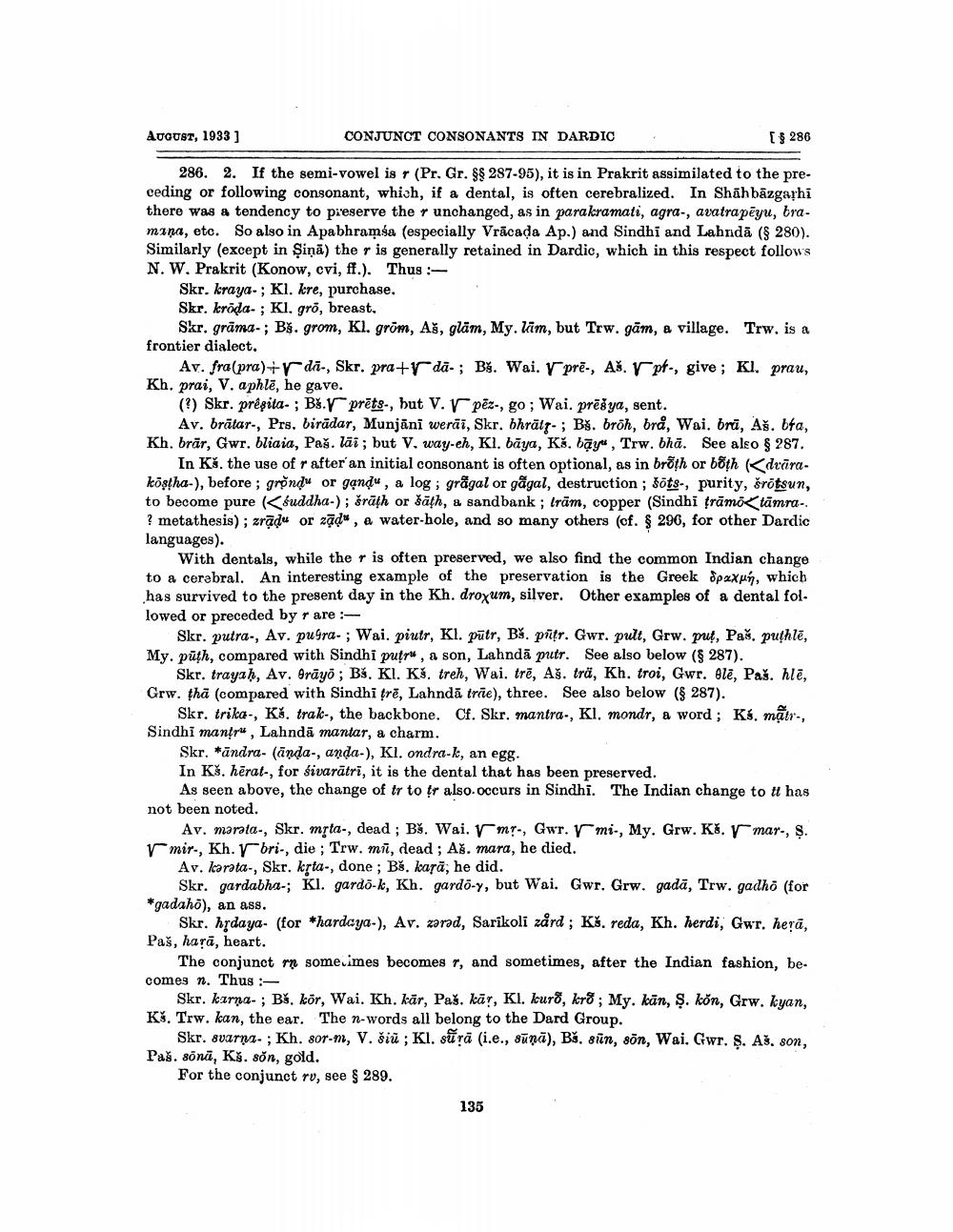________________
August, 1933 ]
CONJUNCT CONSONANTS IN DARDIC
[$ 286
286. 2. If the semi-vowel is (Pr. Gr. S$ 287-95), it is in Prakrit assimilated to the preceding or following consonant, which, if a dental, is often cerebralized. In Shāh bāzgarhi there was a tendency to preserve the r unchanged, as in para kramati, agra-, avatrapēyu, tramana, etc. So also in Apabhramsa (especially Vrācada Ap.) and Sindhi and Lahrdā (& 280). Similarly (except in Şiņā) the r is generally retained in Dardic, which in this respect follows N. W. Prakrit (Konow, cvi, ff.). Thus -
Skr. kraya- ; Kl. kre, purchase. Skr. kröda; KI, gro, breast,
Skr. grāma-; B$. grom, Kl. gröm, Aš, glām, My.lām, but Trw. gām, a village. Trw, is a frontier dialect.
Av. fra(pra)+ r di-, Skr. pra+r dā- ; Bš. Wai. V pre-, Aš. V pt., give; Kl. prau, Kh. prai, V. aphlē, he gave.
(9) Skr. prêgita- ; Bx. prēts-, hut V. r pēz-, go; Wai. prēšya, sent.
Av. brātar-, Prs, birādar, Munjāni werãi, Skr. bhrālr. ; Bš. brāh, bra, Wai, brā, Aš. bta, Kh. brār, Gwr. bliaia, Paš. lāi; but V. way-eh, Kl. bāya, Kš. bay , Trw. bhā. See also $ 287.
In Kš. the use of r after an initial consonant is often optional, as in broth or both drarakostha-), before ; grond or gandu , a log; grågal or gågal, destruction ; Sots-, purity, šrotsun, to become pure suddha-); šrāth or šāțh, a sandbank ; Irām, copper (Sindhi grāmö< tāmra. ? metathesis); zrādu or zad", a water-hole, and so many others (cf. & 296, for other Dardic languages).
With dentals, while the r is often preserved, we also find the common Indian change to a cerebral. An interesting example of the preservation is the Greek Spaxun, which has survived to the present day in the Kh. droyum, silver. Other examples of a dental fol. lowed or preceded by r are :
Skr. putra-, Av. putra-; Wai. piutr, Kl. pūtr, Bš. pift. Gwr. pult, Grw. put, Paš. puthlē, My. pūth, compared with Sindhi puţr", a son, Lahndā putr. See also below ($ 287).
Skr. trayah, Av. Grāyo; Bš. Kl. Ks. treh, Wai, trē, Aš. trä, Kh. troi, Gwr. Blē, Paš. hlē, Grw. thă (compared with Sindhi trē, Lahndā trie), three. See also below (& 287).
Skr, trika-, Kš. trak-, the backbone. Cf. Skr. mantra-, Kl. mondr, a word ; Ks. mậer-, Sindhi manțr", Lahndā mantar, a charm.
Skr. *ändra- (ända-, anda.), Kl. ondra-k, an egg. In Kš. hērat-, for sivarātrī, it is the dental that has been preserved.
As seen above, the change of tr to fr also.occurs in Sindhi. The Indian change to It has not been noted.
Av. marata., Skr. msta-, dead ; Bš. Wai. V mr., Gwr. r mi., My. Grw. Ks. r mar-, . rmir., Kh. V bri-, die ; Trw. mi, dead; Aš. mara, he died.
Av. karata-, Skr. krta-, done; Bš, kasā, he did.
Skr. gardabha-; Kl. gardo-k, Kh. gardo-y, but Wai. Gwr. Grw. gadā, Trw. gadho (for *gadaho), an ass.
Skr. hrdaya- (for *hardaya-), Av. zarad, Sarikoli zård ; Kš. reda, Kh. herdi, Gwr, hera, Paš, harā, heart.
The conjunct mn some imes becomes T, and sometimes, after the Indian fashion, be. comes n. Thus :
Skr. karna- ; Bš, kör, Wai. Kh, kär, Paš. kār, KI. keurd, kr8; My. kan, Ş. kön, Grw. kyan, Kš. Trw. kan, the ear. The n-words all belong to the Dard Group.
Skr. svarna- ; Kh. sor-m, v. šiū ; Kl. sūrā (i.e., sūnā), Bš. sün, son, Wai. Gwr. Ş. Aš. son, Paš. sönā, Kš. sõn, gold.
For the conjunct ru, see $ 289.
135




